Furnish your garden shed beautifully and efficiently
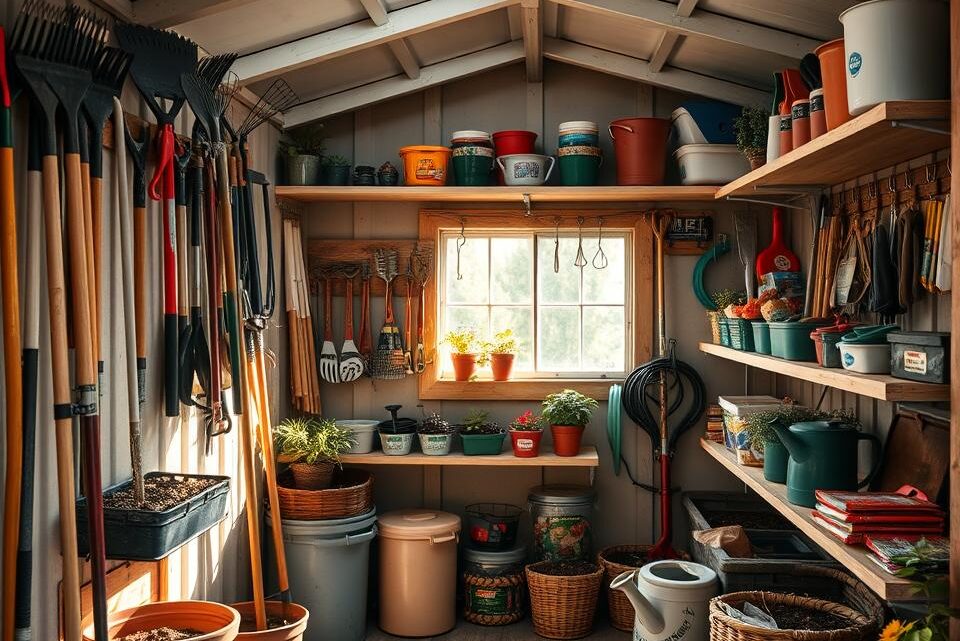
Your garden shed holds incredible potential beyond storing lawn mowers and plant pots. With thoughtful garden shed organisation and creative shed interior design, you can transform this humble structure into a charming retreat. Whether you need a workshop, potting station, or peaceful hideaway, the right approach to garden building furnishings makes all the difference.
Many homeowners overlook their shed’s possibilities, leaving valuable space underutilised. Smart outdoor storage solutions can turn chaos into order whilst creating an inviting atmosphere. An efficient shed layout helps you make the most of every square metre, no matter how compact your space might be.
This guide walks you through practical strategies for furnishing your shed without breaking the bank. You’ll discover how to select pieces that look great and work hard, from clever storage systems to comfortable seating. The right combination of function and style creates a space you’ll actually want to spend time in.
Inhaltsverzeichnis
Key Takeaways
- Transform your shed into a functional extension of your home with proper planning
- Smart storage solutions maximise limited space whilst maintaining visual appeal
- Weather-resistant materials protect your investment throughout the seasons
- DIY projects and upcycling offer budget-friendly furnishing options
- Proper lighting and ventilation create a comfortable working environment
- Multi-purpose furniture serves double duty in compact spaces
Understanding the Potential of Your Garden Shed Space
Your garden shed holds incredible potential beyond simple storage. With thoughtful shed space planning, this versatile structure can transform into a productive workshop, peaceful retreat, or organised gardening station. The key lies in understanding your available space and creating a layout that maximises every square metre.
Assessing Your Shed’s Dimensions and Layout
Start by grabbing a tape measure and recording your garden shed dimensions. Note the internal width, length, and height, paying special attention to door and window placements. These measurements form the foundation of your shed layout ideas.
Create a simple floor plan sketch, marking any structural elements like support beams or built-in features. This visual reference helps you visualise furniture placement and identify awkward corners that need creative solutions.
Identifying Primary Uses for Your Shed
Your multi-purpose shed design should reflect your specific needs. Consider these popular shed functions:
- Workshop for DIY projects and repairs
- Potting station for gardening enthusiasts
- Home office or creative studio
- Organised storage for tools and equipment
- Relaxation space or reading nook
Creating Zones for Different Activities
Dividing your shed into distinct activity zones prevents clutter and improves efficiency. A well-planned workshop might include a tool storage wall, workbench area, and materials corner. Garden sheds benefit from separate zones for potting, seed storage, and equipment maintenance. Even small sheds can accommodate multiple functions when you establish clear boundaries between different activities.
Essential Storage Solutions for Garden Sheds
Transforming your garden shed into an organised sanctuary starts with smart storage. The right shed storage systems can double your usable space whilst keeping tools and supplies within easy reach. From floor to ceiling, every surface offers potential for clever organisation that suits your specific needs.
Wall-Mounted Shelving Systems
Wall-mounted shelves transform bare walls into valuable storage space. Adjustable brackets let you customise shelf heights for different items, from plant pots to power tools. Strong metal or wooden shelves from retailers like B&Q support heavy loads whilst keeping your floor clear. Position them at eye level for frequently used items, or higher up for seasonal storage.
Overhead Storage Options
Ceiling space often goes unused in sheds. Overhead storage racks maximise this area perfectly. Install sturdy ceiling hooks for hanging bicycles, ladders, or garden furniture during winter months. Suspended platforms work brilliantly for storing lightweight boxes and camping gear you don’t need daily access to.
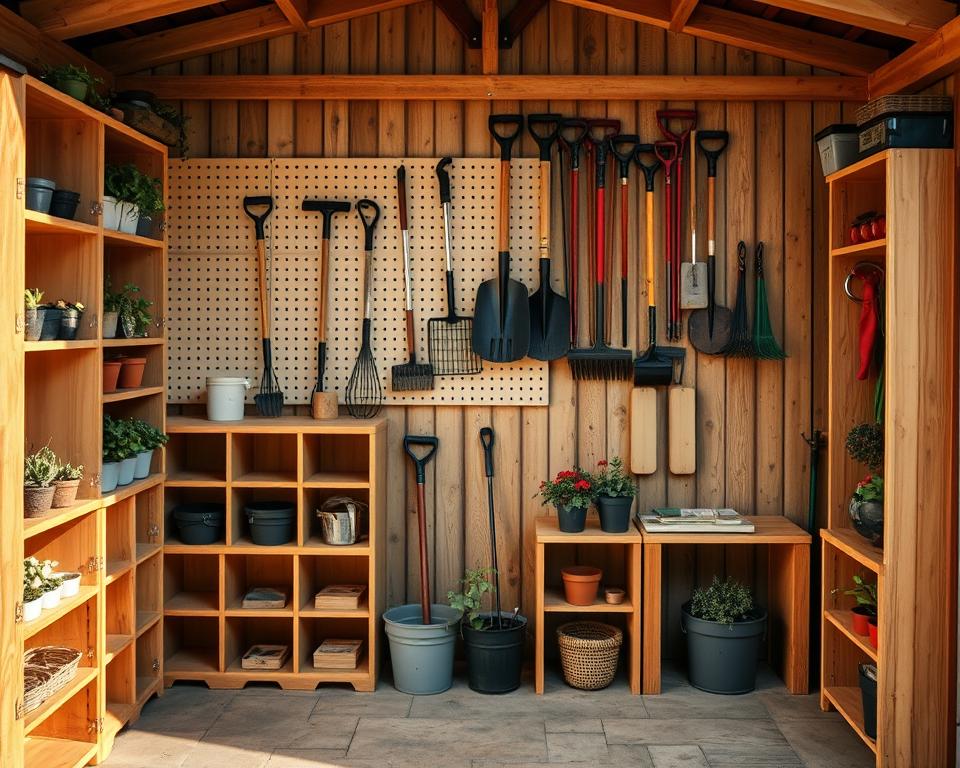
Multi-Purpose Storage Benches
Storage benches serve double duty in any shed. These clever pieces provide comfortable seating for potting plants whilst hiding gardening supplies inside. Choose weather-resistant materials like treated pine or plastic for longevity. Built-in compartments keep small items organised and accessible.
Pegboard Organisation Systems
Pegboard organisation creates visible, accessible tool storage. Mount panels on walls and arrange hooks to suit your collection. Outline tools with markers so you’ll spot missing items instantly. This system adapts as your needs change, making it perfect for growing tool collections.
Furnish Your Garden Shed Beautifully and Efficiently
Transforming your garden shed into a practical yet attractive space starts with smart shed furniture selection. The right pieces can turn a cluttered storage area into an organised retreat that serves multiple purposes whilst looking great.
Choosing the Right Furniture Pieces
When selecting functional shed furnishings, consider pieces that match your shed’s primary purpose. A folding workbench from B&Q provides ample workspace for DIY projects yet tucks away neatly against the wall. Stackable stools from Wilko offer seating without permanent floor commitment. For craft enthusiasts, a wall-mounted desk from IKEA creates a dedicated workspace that folds flat when not needed.
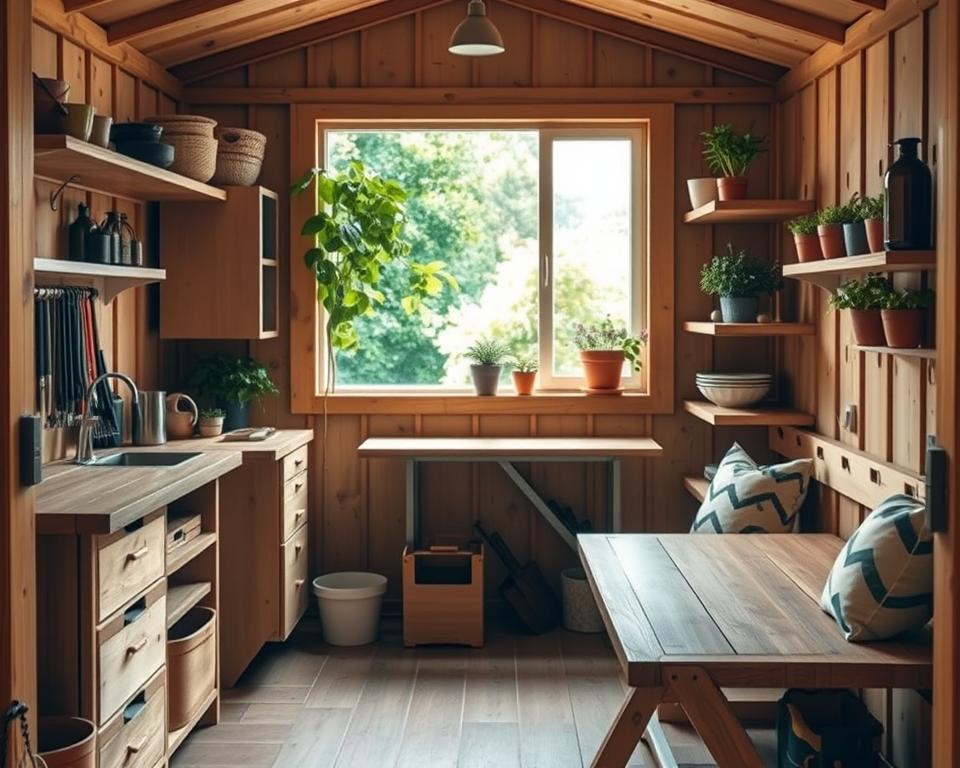
Balancing Aesthetics with Functionality
Your aesthetic storage solutions should work as hard as they look good. Ottoman storage boxes serve triple duty as seating, storage, and decorative elements. Choose colours that complement your shed’s interior – soft greys and whites make small spaces feel larger. Modular cube units from Argos allow you to customise storage whilst maintaining visual appeal.
Space-Saving Furniture Ideas
Compact shed furniture maximises every square metre. Consider these clever options:
- Corner shelving units that utilise awkward spaces
- Magnetic tool strips for vertical storage
- Nesting tables that slide together when unused
- Ceiling-mounted pulley systems for seasonal items
| Furniture Type | Space Saved | Best For |
|---|---|---|
| Folding Workbench | 80% when folded | Workshop sheds |
| Wall-mounted Desk | 100% floor space | Hobby rooms |
| Stackable Seating | 75% when stacked | Multi-use sheds |
| Ottoman Storage | Dual purpose | Any shed type |
Lighting Solutions to Transform Your Shed
Proper illumination can completely change how you use and enjoy your garden shed. Whether you’re potting plants, working on DIY projects, or simply storing tools, the right shed lighting ideas make every task easier and safer.
Start by maximising natural light through existing windows and skylights. *Clean windows regularly* and trim any overhanging branches that block sunlight. Paint interior walls in light colours like white or pale grey to reflect available daylight throughout the space.
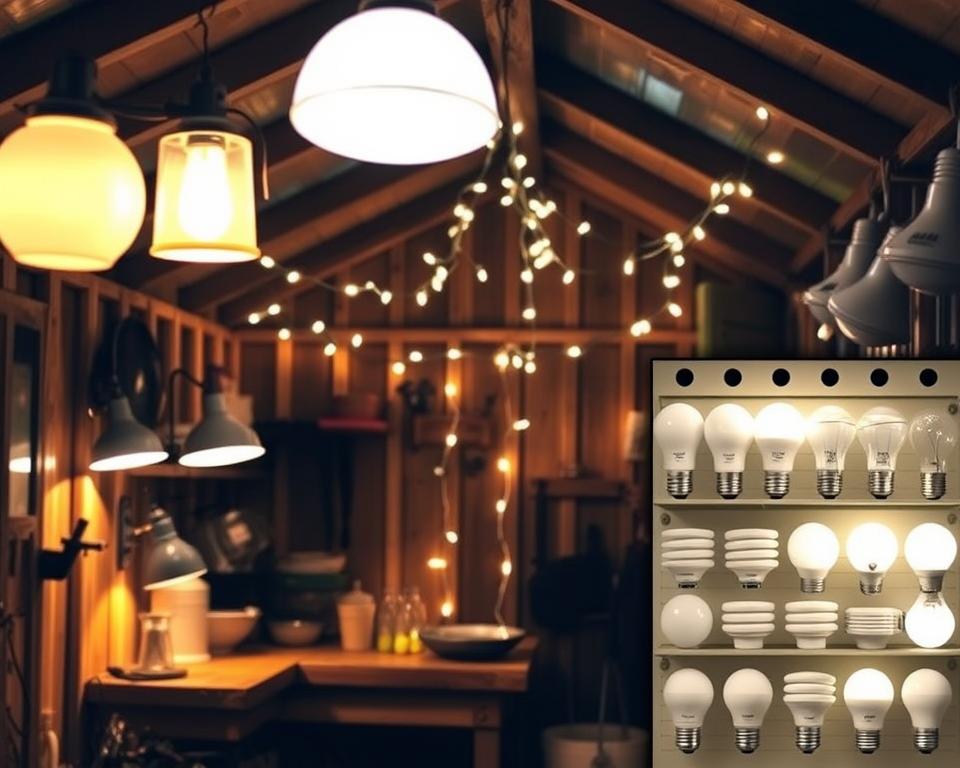
LED lighting solutions offer brilliant illumination whilst keeping energy costs low. Battery-powered LED strip lights work perfectly under shelves and along ceiling edges. These provide ambient lighting without requiring an electrician or complex wiring. Motion-sensor LED bulbs in standard light fittings switch on automatically when you enter, saving battery life and providing instant visibility.
Solar shed lights present an eco-friendly option for sheds without mains electricity. Mount solar panels on south-facing roof sections to capture maximum sunlight. Modern solar lights from brands like Litom and Aootek store enough power to illuminate your shed for several hours after dark.
- Position task lighting directly above workbenches using adjustable clamp lights
- Install magnetic LED work lights on metal surfaces for portable illumination
- Add rechargeable head torches to hooks near the door for detailed work
- Place waterproof LED lanterns in corners for even light distribution
Task lighting remains crucial for precision work. Anglepoise lamps or LED desk lights from Ikea provide focused beams exactly where needed. Mount these on walls or clamp them to work surfaces, ensuring shadows don’t fall across your workspace.
Creating a Comfortable Working Environment
Transforming your garden shed into a productive space requires careful attention to comfort. Whether you’re crafting, potting plants, or tackling DIY projects, the right comfortable workspace setup makes all the difference. A well-planned environment keeps you focused and productive throughout the year.
Temperature Control Options
British weather can be unpredictable, making shed climate control essential for year-round use. Electric heaters provide instant warmth during chilly mornings, whilst oil-filled radiators offer steady, cost-effective heating. For summer months, portable fans or small air conditioning units prevent your shed from becoming stifling.
Smart temperature regulation starts with proper insulation. Installing foam boards or fibreglass batting in walls and ceilings maintains stable temperatures. Weather stripping around doors and windows prevents draughts, keeping your energy costs down.
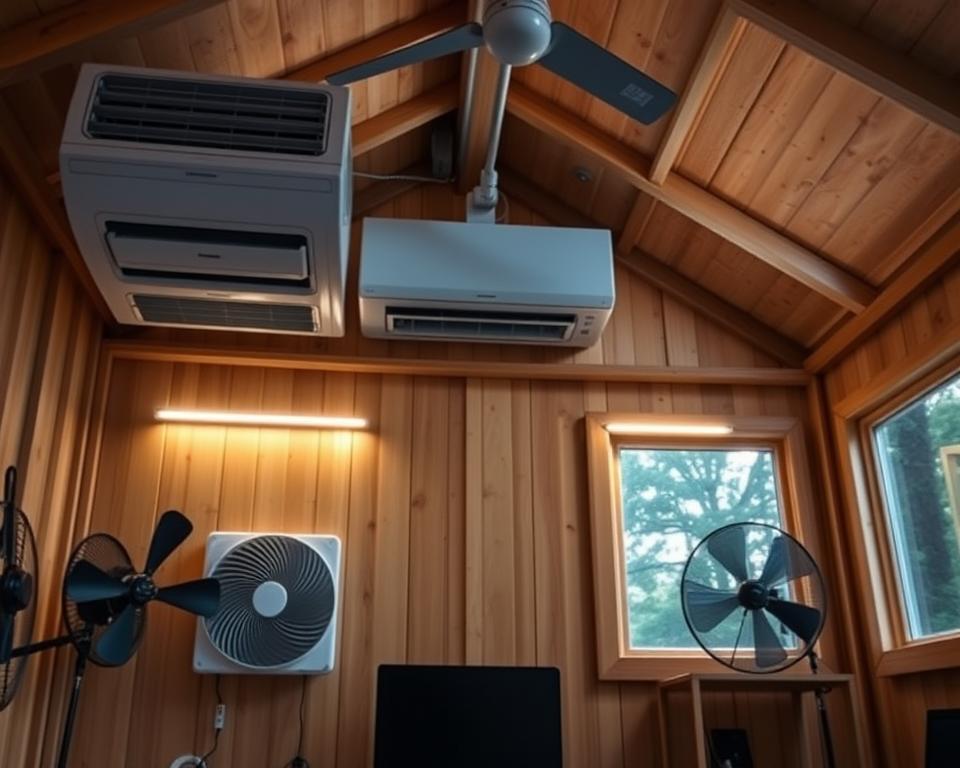
Ventilation and Air Circulation
Good ventilation systems prevent condensation build-up that damages tools and materials. Install ventilation grilles near the floor and ceiling to create natural airflow. For workshops using paints or adhesives, an extractor fan removes fumes quickly.
Opening windows regularly refreshes stale air, but fixed louvre vents provide constant circulation without compromising security. Position vents on opposite walls for cross-ventilation that keeps air moving naturally.
Ergonomic Workspace Design
An ergonomic shed design reduces strain during long work sessions. Set workbenches at elbow height to prevent back pain. Adjustable stools accommodate different tasks and users. Anti-fatigue rubber matting cushions feet during standing work, increasing comfort significantly.
Good organisation supports ergonomics too. Keep frequently used tools within easy reach. Install task lighting to reduce eye strain. These simple adjustments create a workspace that supports both productivity and wellbeing.
Decorative Elements That Make a Difference
Transforming your garden shed from a simple storage space into an inviting retreat requires thoughtful attention to decorative details. The right combination of colours, textures, and personal elements can create a space that feels both functional and welcoming. Small touches make a significant impact in compact areas, turning your shed into a charming extension of your home.
Colour Schemes for Small Spaces
Selecting the perfect small space colour schemes can dramatically alter your shed’s atmosphere. Light, neutral tones work brilliantly in compact areas. Consider shades like Farrow & Ball’s ‘Pointing’ or Dulux’s ‘Natural Calico’ to create an airy, spacious feel. These soft hues reflect natural light and prevent the space from feeling cramped.
For those seeking bolder shed decor ideas, accent walls in sage green or dusty blue add character without overwhelming the space. Paint your decorative storage units in complementary tones to create visual harmony. White or cream ceilings help bounce light around the room, making your shed feel larger and more inviting.
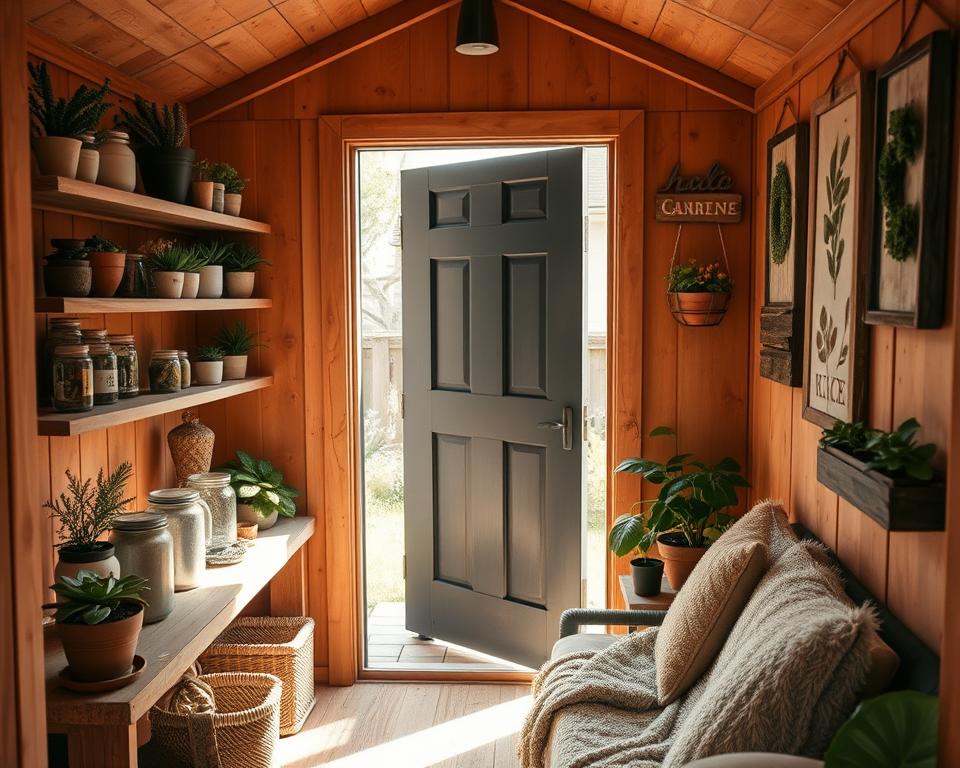
Adding Personal Touches and Character
Your personalised shed design should reflect your interests and passions. Display vintage gardening tools on wall-mounted hooks as functional art pieces. Botanical prints in simple frames add natural beauty without cluttering surfaces. Family photographs arranged on a dedicated shelf bring warmth and personality to your workspace.
Consider incorporating these character-building elements:
- Antique watering cans as planters
- Hand-painted signs with gardening quotes
- Collections of seed packets in shadow boxes
- Restored wooden crates for decorative storage
Window Treatments and Soft Furnishings
The right window treatments balance privacy with natural light. Roman blinds in linen or cotton offer adjustable coverage whilst maintaining a neat appearance. Café curtains work wonderfully for shed windows, providing privacy at eye level whilst allowing light to flood in from above.
Soft furnishings add comfort and style to your shed interior. Choose weather-resistant fabrics for cushions and throws – outdoor textiles from brands like Sunbrella resist moisture and fading. Layer different textures through woven baskets, jute rugs, and canvas storage bins. These elements soften hard surfaces and create a cosy atmosphere perfect for spending time in your beautifully furnished garden retreat.
Maximising Floor Space with Smart Layouts
When working with compact shed design, every square centimetre counts. The key to successful space maximisation lies in thoughtful planning and strategic furniture placement. By arranging your storage and work surfaces along the perimeter walls, you’ll maintain an open central area that allows for easy movement and access to all your tools and equipment.
Consider these proven strategies for efficient shed layouts:
- Position tall storage units and shelving against walls to preserve floor space organisation
- Install L-shaped workbenches in corners to utilise otherwise wasted areas
- Keep everyday tools at waist height whilst storing seasonal items on upper shelves
- Leave at least 60cm clearance for pathways between furniture pieces
Smart shed floor plans focus on creating distinct work zones without cluttering the space. Place your potting bench near the window for natural light, position tool storage close to the entrance for quick access, and dedicate a corner for larger equipment. This approach to floor space organisation ensures that cupboard doors and drawers can open freely without bumping into other items.
Remember that efficient shed layouts aren’t just about cramming in storage. Leave breathing room between furniture pieces to prevent your shed from feeling cramped. Triangle-shaped corner shelves and wall-mounted fold-down tables are brilliant solutions for maintaining functionality whilst preserving precious floor space in your compact shed design.
Weather-Proofing and Protecting Your Furnishings
Garden sheds face constant exposure to British weather, from damp winters to occasional hot summers. Protecting your weatherproof shed furniture requires a strategic approach to prevent damage and extend the lifespan of your investments. The right combination of materials and maintenance practices will keep your shed furnishings looking brilliant year-round.
Moisture Control Strategies
Dampness poses the biggest threat to shed contents in the UK climate. Effective moisture control starts with simple solutions that make a significant difference. Place silica gel packets in storage boxes and drawers to absorb excess humidity. Electric dehumidifiers work brilliantly for larger sheds, maintaining ideal humidity levels between 40-60%.
Proper ventilation plays a crucial role in moisture control. Install vents near the roof and floor to create natural airflow. Check door and window seals regularly, replacing weatherstripping when gaps appear. Good drainage around your shed’s foundation prevents water from seeping through the floor.
Choosing Weather-Resistant Materials
Selecting the right weather-resistant materials makes shed maintenance much easier. Each material offers unique benefits for different applications:
| Material Type | Best Uses | Lifespan | Maintenance Required |
|---|---|---|---|
| Galvanised Steel | Shelving units, tool racks | 15-20 years | Annual rust inspection |
| Marine-Grade Plywood | Workbenches, cabinets | 10-15 years | Yearly sealant application |
| Treated Timber | Structural supports, benches | 8-12 years | Annual preservative treatment |
| Plastic Resin | Storage boxes, lightweight shelves | 20+ years | Simple cleaning only |
Seasonal Maintenance Tips
Regular protective treatments keep your shed furnishings in top condition throughout the year. Spring marks the perfect time to apply wood preservatives like Cuprinol or Ronseal to timber surfaces. These products penetrate deep into the wood, providing protection against rot and insect damage.
Create a simple maintenance schedule:
- Spring: Apply protective treatments to wooden surfaces
- Summer: Check ventilation systems and clean gutters
- Autumn: Seal any gaps before winter weather arrives
- Winter: Monitor humidity levels and run dehumidifiers regularly
Small efforts in shed maintenance prevent costly replacements later. Weather-resistant materials combined with proper care ensure your garden shed remains a functional, attractive space regardless of the season.
Budget-Friendly Shed Furnishing Ideas
Creating a beautiful and functional shed doesn’t require breaking the bank. With clever planning and resourcefulness, you can transform your garden shed into an organised space using cost-effective solutions that work just as well as expensive alternatives. Whether you’re setting up a workshop, potting shed, or creative studio, these budget shed ideas will help you achieve professional results without the hefty price tag.
DIY Projects for Custom Storage
Building your own DIY shed storage allows you to create perfectly sized solutions for your space. Reclaimed scaffold boards paired with sturdy metal brackets make excellent shelving that’s both affordable and characterful. Old kitchen cabinets destined for the skip can find new life as tool storage units – simply secure them to your shed walls and add hooks or dividers inside.
Upcycling and Repurposing Furniture
Transform forgotten pieces into functional shed furnishings with a bit of creativity. An old bookcase becomes a potting station, whilst wooden pallets can be converted into vertical garden tool racks. Upcycled furniture not only saves money but adds unique character to your space. Sand down that tired chest of drawers and give it a fresh coat of paint for storing seeds, gloves, and small tools.
Where to Find Affordable Shed Accessories
Car boot sales and online marketplaces like Gumtree or Facebook Marketplace are treasure troves for affordable shed accessories. Discount retailers such as The Range and Wilko stock practical organisation solutions at pocket-friendly prices. Keep an eye out for end-of-season sales at garden centres, where storage boxes, hooks, and decorative elements are often heavily reduced.
Conclusion
Your garden shed transformation journey doesn’t have to be overwhelming. With careful planning and the right approach, you can turn any humble shed into a stylish and functional space. This shed furnishing guide has shown you practical ways to maximise every square metre whilst keeping your personal style at the forefront.
Creating an organised outdoor space starts with understanding your shed’s unique potential. From clever storage solutions to weather-resistant materials, each element plays a vital role in your efficient shed design. The combination of wall-mounted systems, comfortable workspaces, and thoughtful lighting can completely change how you use and enjoy your shed.
Beautiful garden storage is within reach, regardless of your budget or DIY skills. The strategies we’ve explored help you balance practicality with aesthetics, ensuring your shed becomes a valuable extension of your home. Whether you’re storing tools, creating a workshop, or designing a peaceful retreat, these ideas will help you achieve a space that works perfectly for your needs.
FAQ
What’s the best way to maximise storage in a small garden shed?
The key to maximising storage in a small shed is to think vertically. Install wall-mounted shelving systems from retailers like B&Q or Wickes, use overhead storage racks for seasonal items, and invest in multi-purpose furniture like storage benches. Pegboard systems are brilliant for hanging tools whilst keeping floor space clear. Don’t forget to utilise corner spaces with triangular shelving units.
How can I make my garden shed comfortable to work in during winter?
To create a comfortable winter workspace, install a small electric heater or oil-filled radiator for warmth. Add proper insulation to walls and ceiling if possible, and use weatherstripping to seal any gaps. Rubber matting provides comfort and insulation from cold floors. Ensure adequate ventilation with grilles or a small extractor fan to prevent condensation build-up.
What type of lighting works best for a shed without electricity?
Battery-powered LED strip lights offer excellent ambient illumination without complex wiring. Solar-powered lights positioned near windows can harness natural energy effectively. For task lighting, consider rechargeable LED desk lamps or motion-sensor lights for convenience and energy efficiency. These options provide adequate lighting for various activities without requiring mains electricity.
Which materials should I choose for shed furniture to prevent weather damage?
Opt for weather-resistant materials such as galvanised steel shelving, treated timber, or marine-grade plywood. Apply wood preservatives like Cuprinol or Ronseal annually to protect wooden surfaces. For soft furnishings, choose weather-resistant fabrics that can withstand moisture. Consider using silica gel packets or a dehumidifier to control moisture levels inside the shed.
Can I transform my shed into a home office on a budget?
Absolutely! Start by checking Gumtree or Facebook Marketplace for second-hand desks and chairs. Create custom shelving using reclaimed scaffold boards and metal brackets. Shop at discount retailers like The Range or Wilko for affordable organisation accessories. Consider a wall-mounted folding desk from IKEA to save space. With some creativity and smart shopping, you can create a functional home office without breaking the bank.
What colour schemes work best for making a small shed feel larger?
Light, neutral colours create an airy, spacious feel in small sheds. Consider shades like Farrow & Ball’s ‘Pointing’ or Dulux’s ‘Natural Calico’ for walls. White or cream painted furniture reflects light and enhances the sense of space. Add pops of colour through accessories like cushions or storage boxes rather than overwhelming the space with dark or bold wall colours.
How do I create different zones in my garden shed for multiple uses?
Start by assessing your shed’s dimensions and identifying primary uses. Divide the space into distinct zones such as tool storage, workspace, and relaxation areas. Use furniture placement to define areas – position workbenches along one wall, create a potting station near windows, and designate a corner for seating. Visual dividers like curtains or open shelving units can help separate zones without blocking light.
What’s the best way to prevent condensation and dampness in my shed?
Proper ventilation is crucial for preventing condensation. Install ventilation grilles or a small extractor fan to ensure air circulation. Use a dehumidifier or moisture-absorbing products like silica gel packets. Seal any gaps with weatherstripping and ensure proper drainage around your shed’s foundation. Regular maintenance, including checking for leaks and applying sealant where needed, helps keep dampness at bay.

